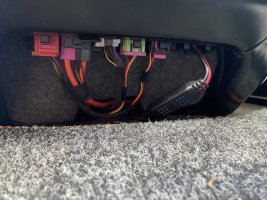Standard approach on the 240v charger is to connect via a socket. On mine I got a rugged extension lead type socket to plug the charger in. I made a consumer unit to go under the bonnet, with the hookup on a flying lead.
More details

 www.t6forum.com
www.t6forum.com
More details

CandyVan conversion journey
Left roof beam back in and trimmed. Original courtesy light refitted, and it lights up, and no blown fuses!



